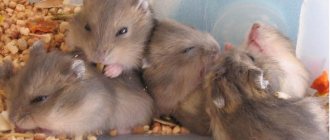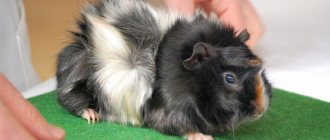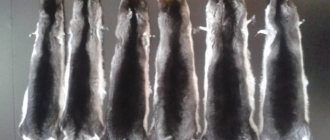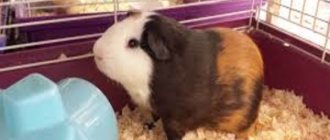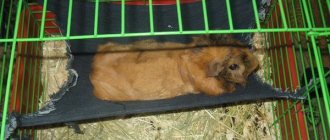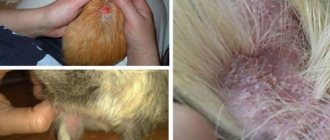When choosing a pet, the question often arises, do guinea pigs stink? They are extremely clean and take very good care of themselves. Every loving owner will confirm this. Like any living creature, they have their own slightly specific smell. Unpleasant odors can emanate from a cage or terrarium, and this is only due to improper care or lack thereof. Follow basic hygiene rules, and there will be no such problems in your home.
Natural smells of guinea pigs
Their own smell is not stinking, but quite tolerable. A guinea pig constantly takes care of itself, you just need to provide it with this opportunity. In the wild, their lives depend on it; strong odors attract predators who don’t mind eating fresh meat. At home, animals also try not to attract unnecessary attention.
A guinea pig stinks under the following circumstances:
- The unpleasant odor comes from an advanced disease.
- Ear infection. Sulfur itself has no odor; its appearance indicates a problem and the animal needs treatment.
- During the mating season, the male marks his territory to attract a female.
- Females can smell when there is a hormonal imbalance; this situation mainly occurs after childbirth.
- Improper maintenance of the pet, basic hygiene rules are not followed.
- The stench comes from a cage that has not been cleaned for a long time.
Content Features
Both Djungarian and Syrian hamsters are solitary animals and live alone in nature. Keeping two or more individuals provokes fights, often with fatal consequences. In addition, animals of different sexes will begin to reproduce uncontrollably.
To keep these types of hamsters, dunes or cages with horizontal rods are used. Floors in it are extremely undesirable, since these animals have no sense of height and regularly fall. You can build a large terrarium with conditions close to natural.
The cage must have a running wheel (for Syrians - from 18 cm in diameter, for Djungarians - from 14 cm). Minimum cage size: 60 × 40 × 30 cm (length, width, height).
The house is chosen from wood or ceramics, and white napkins are placed inside. The feeder should be ceramic or metal, and the drinker should be automatic.
Hamsters are active in the evening and at night. Sometimes they can be seen in the early morning.
Avoiding unpleasant odor
Just take care of the cleanliness around the animal and its health. You need to know this before purchasing a pet. Systematically ignoring the rules of hygiene and cleaning the cage will lead to the appearance of an odor. In advanced cases, bacteria and even fly larvae can develop. The pig will often suffer from colds and possible baldness.
If someone convinces that a guinea pig stinks at home, he simply does not know how to care for it. Such lazy owners spread negative rumors about these cute creatures through their own incompetence.
Litter for rats: which one is better?
The absence of “aroma” from a cage with rats is an important condition that allows you to calmly enjoy communication with your pets. Rat urine has a strong, unpleasant odor, and feces don't smell like roses either.
To prevent animals from getting dirty in their own excrement and to reduce unpleasant fumes, filler is used. You will have to select it through your own experiments, depending on the characteristics of your pets, cage and personal preferences. The main condition is that it must be safe for rats.
Paper fillers
In my time, rats lived without any fuss - on a thick layer of newspapers. The newspaper was replaced daily, which effectively controlled the odor. Nowadays it is not recommended to use newspapers due to the possible toxicity of the paint.
White paper napkins and towels would make great fillers, but they are too expensive. Rats drag the soft material into the houses and quickly chew it into small pieces. Paper napkins are warm, soft, not dusty. They do not cause allergies, respiratory problems, and do not damage the eyes and paws. They are used to furnish a maternity hospital.
An excellent everyday option is industrial paper (cellulose) filler. It is safe for the health of rodents and they really like it. It can be flushed down the toilet. No cons found. However, experienced owners say that if there are a lot of rats, an unpleasant smell appears quite quickly.
Wood fillers
The most common litter for rats is sawdust. He is also the most harmful.
- Dusty (cause inflammation of the eyes and respiratory tract);
- Pine sawdust irritates the respiratory tract due to essential oils.
Cleaning the cage
Take the time to clean the cage regularly. Once a week it is necessary to carry out general cleaning by replacing the filler, washing the cage with detergent and wiping with table vinegar for disinfection. Clean the toilet and contaminated litter layer every day. It is recommended to wash the feeder and drinker every few days so that they are always clean. This way, fewer bacteria will enter the body. Wood products are washed only when necessary.
Cleaning the cage will be much more effective using disinfectants. To do this, you can purchase special sprays, or use improvised methods. At this time, you need to remove the pig, feeder and drinker from the cage. Spray the substance for 5-7 minutes, then wipe dry with a clean cloth. Add fresh filler and return everything to its place.
Never use products that contain bleach; it can seriously harm your pet's health.
PVC mats are cleaned using unique methods. They need to be washed and dried, which takes a lot of time. It's good if there is another rug to replace. Once every six months you need to replace the old rug with a new one.
Hygiene
The smell from guinea pigs and from the cage can appear due to neglect of regular cleaning of the habitat.
Untimely cleaning leads not only to stench, but also to the development of fungal and cold diseases in your pet, and the appearance of fly larvae. If kept clean, the cage should smell like sawdust and fresh hay.
The frequency of cleaning depends on several factors:
- the size of the cage, in a very small one the pet will have to defecate literally under itself;
- the number of animals contained in it; the more there are, the more often cleaning will have to be done;
- the type of filler used, the degree of moisture absorption and odor binding depends on it.
The cage will stink if there are many animals in a small space
Cleaning the cage
A complete cleaning of the cage should be done approximately once a week. At the same time, the filler is completely changed, the cage tray, feeders and drinking bowls are washed. Laundry or baby soap is suitable for washing. A 10% vinegar solution works well to eliminate miasma and urine stains. The use of strong chlorine-based cleaning products is not recommended.
A special spray for cleaning cages, which is sold in pet stores, is very convenient. It eliminates stool odor and is safe for pets. It is enough to spray the tray with spray and after a few minutes wipe it with a clean, dry cloth. It is not necessary to wash the tray after spraying.
Medium-fraction sawdust without flavorings, shavings, hay, corn or paper filler are suitable fillers. Small sawdust generates dust and causes sneezing. Some owners use reusable PVC mat and fleece bedding, which are laid on top of the filler. The mat allows moisture to pass through, thanks to which the animal’s paws always remain dry.
You can use paper towels, napkins, toilet paper, but you will have to change them much more often. Another option is absorbent diapers. If you place a fleece or PVC mat on top of the diaper, the rodent will not be able to gut it.
To prevent guinea pigs from stinking, you need to regularly change the litter in the cage.
Daily animal care includes cleaning up leftover juicy and stale food, washing feeders and replacing litter in the toilet.
Toilet
An attentive owner will notice that the pet prefers one of the corners of its home to perform its natural needs. To make cleaning easier, you should install a homemade toilet or one purchased from a pet store in this place.
Compressed sawdust in the form of granules is ideal as a filler.
There will be no rodent smell if you change the litter in the tray daily and wash it with soda
The litter tray should be cleaned daily by rinsing it with a soda solution. Before adding fresh litter, you can also add a little baking soda to the bottom of the tray to prevent odor.
Water treatments
Pigs do not need regular bathing; they take excellent care of their fur on their own. Regular brushing with a soft-bristle toothbrush can help with care. Long-haired animals can have their fur trimmed a little to make it less dirty. But sometimes the need for bathing may arise, for example, on the recommendation of a veterinarian after certain illnesses, or when the cage is too dirty, especially for pets with long coats.
There is no need to wash your pets more than once a month. Frequent bathing washes away the natural fatty layer on the skin, which performs a protective function, and bald patches may appear.
You shouldn't wash your guinea pig often, it doesn't stink that much
They bathe the animals in warm water, filling a basin with a small amount of water. Rodents are gradually accustomed to the procedure. Avoid getting water in your ears. During the washing process and after it, you can treat your pet with a particularly tasty treat.
Toilet training
If your pet is toilet trained, cleaning is much easier and can be done less often. To prevent odors from emanating from your guinea pig's cage, it is enough to clean the toilet once a day. Since there will be no feces on the litter, it can be changed less often.
It will not be possible to accustom a pig to a specific place; you will have to adapt to it. The pet chooses a specific place and relieves itself there. Find out where it is and put a toilet there. Lay an old bedding soaked in its scent inside. You can even put litter with fecal residues. So, the pig will intuitively understand that this is exactly the place where she always goes. Some owners reward the animal with treats. It happens that a guinea pig refuses to go to the designated toilet, in which case it is moved to another place.
It is important to clean the toilet with disinfectant every time. For these purposes, you can use soda, which is poured onto the bottom, the filler is placed on top and placed back in the cage. In this way, it is possible to delay the appearance of odor in the cage of the sea warbler.
Feeding
The herbivore guinea pig, reviews of which can be read in our article, prefers fresh grass of all foods. At the same time, hay should always be in the pig's feeder, even if you pamper it with its favorite treat. The fact is that when eating hay, the animal develops a correct bite, grinding down the incisors, which in these rodents grow throughout their lives.
When purchasing hay at a pet store, pay attention to its smell and color: fresh hay has a light “summer” aroma of cut grass and it is usually green in color. If you smell rotten or notice a yellowish-brown color, do not purchase
Among vegetables, guinea pigs undoubtedly prefer carrots. When giving your animal a favorite root vegetable, rinse it thoroughly with warm water. Cute rodents will not refuse:
- pears;
- beets;
- dill;
- parsley;
- apples;
- pumpkins;
- Chinese cabbage;
- bananas;
- corn leaves;
- salad;
- bell pepper;
- cucumbers;
- watermelon rinds.
Citrus fruits (tangerines, tangerine peel, oranges) are strictly prohibited for guinea pigs. The pig should be fed at the same time every day. Some breeders recommend feeding their pets 2-3 times a day. But, since rodents eat often and little by little, in the morning you can put the daily amount of green food and grain into the feeder, adding hay during the day as needed. Grain makes up a third of the animal's daily diet. Owners should remember that its abuse can lead to obesity in the pig.
Minerals and vitamins are essential for guinea pigs. Reviews from breeders indicate that you can replenish their supply by buying her a mineral stone and a salt wheel. The animal will come up and bite off a piece of them when the body needs table salt or minerals.
Water treatments
If the pig starts to smell, some owners try to wash it in water. Remember, a pet takes much better care of itself than a human can. Some tips regarding hygiene:
- You can wash the animal only with a special product. Do not use regular shampoos or soaps.
- Bath your pig only when absolutely necessary. After the procedure, wrap in a towel until completely dry. Do not use a battery or hair dryer for this.
- Before you start bathing, you need to accustom your pet to the bath. To do this, first pour a minimum amount of water and gradually increase it over time. So that the animal understands that this is beneficial and does not become capricious, it is given a treat.
- For hygiene, you can comb and even cut a little.
- You should not wash your pig more than once a month. Leather oil, which performs a protective function, can be easily washed off.
Do hamsters smell and if so, why?
Anyone who has kept these rodents knows that an unpleasant odor from healthy hamsters does not appear immediately, but a week after cleaning. The time period can increase or decrease depending on the number of individuals in the cage. This indicates that it is time to clean and wash the cage, because healthy animals themselves do not have a smell - it is their excrement that accumulates.
To understand the reason for the unpleasant aroma of a hamster, you need to sniff the animal and the cage separately.
Why does the hamster itself stink:
- The smell came from dirty wool.
- The rodent is stressed.
- The pet is sick.
If nothing has changed after cleaning the cage, the reason is in the animal itself.
Stress in pets occurs due to various reasons - loud noises, moving the house to a new place, or close attention from cats or other animals. Some breeds of rodents can emit a scent due to the fight for territory with other males (this is what “Syrians” do)
To return the fluffy to normal, you need to seat the partners in other cages or let him get comfortable in a new place. He will calm down and the inconvenience will disappear by itself.
Nutrition
Whether a guinea pig smells or not also depends on proper nutrition. Some foods can cause indigestion and diarrhea, these include: Brussels sprouts, broccoli, crispy lettuce and others. Together with them it is better to give other varieties of cabbage, parsley, turnips, sweet peppers, etc.
When your guinea pig still smells bad and you don’t have enough time to clean it regularly, spread hay with mint, cilantro or other aromatic herbs underneath it.
Chinchilla
Chinchillas are very active and beautiful rodents with long mustaches, a fluffy tail and a thick fur coat. These animals are very clean and tidy - they practically do not smell. Their activity peaks at night, as they are nocturnal animals. Chinchillas need a spacious cage with various shelves, climbing devices and toys.
You need to place a container with sand in the cage; the animal loves to take sand baths. Chinchillas' fur is very dense and does not harbor fleas and ticks. This animal does not shed, so people with allergies can get such a pet. Chinchillas do not bite or scratch, although they have sharp teeth.
These rodents eat little; when kept at home, they are fed once a day with dried foods - dried apples, carrots, hay, dandelion roots, as well as granules as the main food.
One of the advantages of chinchillas over other domestic rodents is their life expectancy. With proper care, these animals can live on average 15-20 years.
When Can Guinea Pigs Really Smell?
If a guinea pig develops an odor that is clearly unrelated to hygiene and mating season, it has a health problem. Most likely, a disease or serious pathology is developing. It is recommended to contact your nearest veterinarian as soon as possible. He will make a diagnosis and prescribe treatment. If there is no money for special medications, you can treat on your own and using traditional methods, but to do this you need to be sure what exactly is happening to the animal. Without a correct diagnosis it is impossible to carry out treatment.
Standards for keeping pigs in the private sector with neighbors
In accordance with Art. 18 Federal Law “On Veterinary Medicine”, animal owners are responsible for their health, maintenance and use. Farmers are also responsible for producing safe products when it comes to selling meat and other farm goods.
The article lists the responsibilities that must be observed by citizens engaged in raising livestock, including for their own consumption.
Order No. 114 sets out the basic rules and states that not only the pig farm is built according to the standards, but also the area around it must be fenced. The fence is designed to prevent wild animals from entering.
Additionally, consider the following factors:
- The room must correspond in size, that is, standards for their comfortable and healthy growth are assigned to each piglet and they must be taken into account during construction.
- Pigs must live separately from other animals.
- A person is supposed to enter a pigsty only in special clothing, used only while inside and washed regularly.
- Disinfection of the premises is carried out according to the schedule you set.
- The farm is cleared of manure every day. It is stored and subjected to biothermal disinfection in a specially designated place, but on the territory of the given farm (for example, in a biocomposter). It is prohibited to dispose of pig manure by transporting it off-farm (but it can be sold...).
- Feed used for pigs must meet all veterinary and sanitary requirements. They also need to have a separate room, which will be treated with special means.
- All animals are vaccinated and subject to mandatory registration and identification by a veterinarian.
- Slaughter and disposal are also carried out according to certain rules. Disposal of corpses takes place according to a special procedure; it is forbidden to make cattle burial grounds on your territory.
These requirements and their compliance will not only allow you to raise a healthy animal, but also not harm others, including people living next door. Thus, an ordinary barn is not suitable for pig breeding purposes; construction must be approached seriously and thoughtfully.
Treatment of parosmia
To begin with, drug treatment is used. Physiotherapeutic hardware techniques can be prescribed in combination.
If medications do not work, surgery to remove the damaged sensory receptors (olfactory mucosa) in the nasal cavity will be considered.
When looking for alternative conservative ways to treat parosmia, you can try olfactory training: inhaling a certain smell and remembering what that smell should smell like. So, if you smell a lemon, you should think about what a real lemon smells like.
Reviews indicate that this may be an effective treatment for parosmia. In a recent study, patients who exercised for six months showed clinically significant improvements in their ability to accurately smell.
As for how to treat parosmia after covid, there is no specific specific therapy. It is treated in the same way as any parosmia caused by a viral infection. In many cases, parosmia after coronavirus can partially or completely go away without treatment at all.
The ENT clinic in Chertanovo treats parosmia, including those caused by Covid, using the full range of highly effective conservative treatment methods.
Electric models
Beginners should pay attention to more innovative gadgets. They are definitely a little more expensive
But in this case, the price increase proportionally affects safety.
We are talking about a family of rechargeable machines equipped with a rotating head. They do not cut, but grind down the cornea. With this approach, it is almost impossible to harm a dog or cat by catching too much of a nail. The high rotation speed of the tip ensures fast operation, and the low noise level does not bother four-legged patients at all. Any beginner can easily cope with such a mechanism.
Price – 481 – 1,859 rubles.
Some models are equipped with 2-3 heads, suitable for dogs or cats of various breeds and age groups.
After all, the claws of a dwarf poodle are much more delicate than those of a German shepherd. The same applies to young kittens and adult cats - their paws need to be treated with different elements. So, when purchasing a tool for trimming claws, you should consider this nuance.
Cost – 567 – 1,189 rubles.
The final touch is the rotation speed of the device head.
It directly affects the quality of claw grinding. After all, it is necessary not only to cut off the ends, but also to polish the ends so that the sharp edges do not injure the delicate pads of the paws. This operation is best done in a more gentle mode at low speeds. So a machine with gear shifting will come in very handy in this case.
Price – 497 – 1,566 rubles.
I like it I don't like it
Express methods
There are many answers to the question of how to urgently remove bad breath. Here are the most effective express ways to get rid of bad breath.
- Chewing lemon, lime. This method will not eliminate the stench forever, but it will get rid of it for a few hours. You need to chew a piece of lemon or lime along with the peel. It is also recommended to use citrus zest as an emergency medicine, which you can always carry with you in a fabric bag.
- Coffee. Among coffee lovers, it is rare to find people with bad breath. Caffeine is known to kill unpleasant odors. If you can’t drink a cup of aromatic drink, it is recommended to gnaw 3-4 coffee beans (which you need to put in your pocket or purse in advance). This method will relieve the stench for 7-8 hours. It is not suitable for people suffering from periodic or constant increases in blood pressure. Hypertensive patients are better off chewing a few sprigs of dill or parsley. This method will not only freshen your breath for 8 hours, but also cleanse the oral cavity of bacteria.
- A sprig of cloves helps with terrible odor in the mouth. All you need to do is chew it for a few seconds. Clove essential oil extracted from the plant will not only refresh the oral cavity, but also lift your spirits.
- Juniper will help hide fumes well. It is recommended to chew the berries for several minutes. This method is capable of defeating even the strongest amber after active celebrations with the consumption of large quantities of alcoholic beverages.
- Sour apples can also combat this problem. Fruits will get rid of plaque, bad breath and improve the functioning of the digestive system.
- To get rid of the problem, it is recommended to chew pine nuts or roasted seeds for a few minutes. This will provide fresh breath for 1-2 hours and even get rid of the smell of garlic and onions.
- If you consume half a teaspoon of propolis daily, this will help eliminate stench and accelerate the regeneration of the mucous membrane during the development of inflammatory processes.
- A salt solution will also help get rid of the problem. To do this, you need to rinse your mouth with salty liquid (or sodium chloride 0.9%) for 2-3 minutes. It kills odor and destroys bacteria.
- If you rinse your mouth with any vegetable oil in the morning, it will relieve bad breath for several hours.
It is also recommended to use wormwood for chewing. The plant eliminates bacteria, restores the functioning of the gastrointestinal tract and eliminates bad breath. Magnolia has the same properties. All you need to do is chew the plant for 1 minute.
Where is the best place to buy
There are three options for purchasing a pet:
- in a pet store;
- from breeders;
- through the Internet.
Purchasing in stores is simple and convenient: together with your pet, you immediately purchase a cage, bowl, water bowl and other accessories. Disadvantages include the inability to verify the health of the pet. The pedigree also remains unknown, which makes it impossible to find out whether there were cases of hereditary diseases in the animal’s family.
Once in the store, you should pay attention to the conditions in which the animals are kept - whether their bedding is clean, what the smell is, etc.
Breeders' prices are higher than in pet stores, but the animal is accompanied by the necessary health and vaccination certificates, pedigree details, and medical history of relatives. It is possible to choose a guinea pig from several individuals of different colors. In addition, the breeder will share useful information regarding the care and feeding of the pet. You should not trust the seller in absentia. Before contacting him, it is useful to read reviews from former customers.
The most budget-friendly option is to find an advertisement on the Internet about free distribution of guinea pigs. The reason for such generosity is the need to give away cubs, the inability to care for a pet, or an unexpected allergy. In this case, all the risks remain the same as when purchasing from a pet store.
Owner reviews
Owners who are not lazy about maintaining hygiene in their pet’s home admit that the animal itself does not smell. However, there are also people who claim that their guinea pig’s smell is not due to a dirty cage. This may be true due to the peculiarity of the organism. In general, everyone agrees that these rodents are ideal pets for those who do not want to “spoil the air” with animal odors. Natural instincts force guinea pigs to get rid of any smell. In one cage, a rat or rabbit smells much stronger than a whole “pig family”.
Rules for building a pigsty: distance to the neighbor’s plot
The rules can be found in. So, the pigsty should be located in such a way that the distance from the wall to the neighboring territory is at least 10 meters. This is provided that there are no more than 5 piglets in this room.
If the livestock increases, then the distance must be greater, namely, 8 piglets should be raised in a pigsty located 20 m from the neighboring plot, 10 at 30 m, 15 at 40 meters. It must be assumed that in urban conditions it is almost impossible to provide such a distance, since the plots of land themselves are small for such purposes. In addition, the smell from the activity of pigs will make the life of neighbors unbearable. They will start swearing and flooding them with complaints about such an economy, the state. The authorities will be tormented by inspections.
When constructing a building intended for keeping piglets, it is necessary to comply with the area standards set for each patch. The room must have artificial or natural ventilation to ensure a microclimate that meets the standards.
Pigs should be provided with either free-range housing or walking in a limited area and under a canopy.
The materials that can and should be used during construction are also specified. They must be resistant to excessive humidity and the effects of disinfectants. Plus, they cannot be toxic or emit harmful substances.
All this must be taken into account in order to raise a healthy pig population and to respect the rights of third parties.
Housing for a pet
Guinea pigs are kept in fairly spacious cages, which should be well ventilated, but at the same time protect the animal from drafts. A layer of sawdust about three centimeters thick is laid on the floor of the cage. Choose sawdust that is not too small; it should not get into the animal’s respiratory tract. Sawdust should be changed regularly. If this is not done, not only they, but also your pet may develop an unpleasant odor.
Observe which part of the cage the pig has allocated for the “toilet”, and place another container with sawdust there. If you clean it daily, the entire cage can be cleaned less frequently. The cage should be installed in a bright, warm and draft-free place. It is not recommended to place it near heating devices or in direct sunlight.
In the cage it is necessary to install a feeder, a drinking bowl and a resting house for your pet.
Bottle with drinker
Such an accessory will come in handy during street walks. It does not take up much space, weighs little and does not hinder movement. But you can offer the dog to quench his thirst at any time, and not wait until he starts drinking from a dirty puddle or lake overgrown with mud.
The device consists of a water container and a bowl equipped with a dispenser button. It allows you to release as much liquid from the bottle as the animal needs to quench its thirst. Sold in two volume options - 350 and 550 milliliters.
Price – 475 – 584 rub.
Another model of the same device has a folding shape, which makes it easier to carry. The transformer connects the bowl and the bottle, securely fixing them in such a compact state. The durable polymer material has good shockproof properties and can even resist dog teeth. True, this struggle will not be long and - if the owner is careless - then all the liquid will end up on the ground.
Volume 250 ml.
Cost – 133 – 148 rubles.
I like1I don't like

